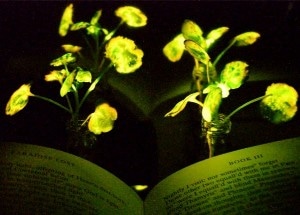Dec 14 2017
The 2009 film “Avatar” produced a lush imaginary world, illuminated by glowing, magical plants. Now scientists are working to bring this fascinating vision to life in order to help reduce the dependence on artificial lighting. In ACS’ journal Nano Letters, they report a technique to infuse plants with the luminescence of fireflies.
 Plants infused with the luminescence of fireflies could help reduce our dependence on conventional lighting. Credit: American Chemical Society
Plants infused with the luminescence of fireflies could help reduce our dependence on conventional lighting. Credit: American Chemical Society
Nature has created many bioluminescent organisms, but plants are not among them. So far, many efforts made to create glowing greenery, decorative tobacco plants in particular, have dependent on introducing the genes of luminescent fireflies or bacteria through genetic engineering. However, it has been a challenge to get all the correct components to the correct locations within the plants. Based on this, the scientists wanted to move ahead and create a “nanobionic,” glowing plant.
The scientists infused watercress and other plants with three types of nanoparticles in a pressurized bath. The nanoparticles contained light-emitting luciferin; coenzyme A, which increases luciferase activity; and luciferase, which modifies luciferin and makes it glow.
The scientists could optimize how much light was emitted by using size and surface charge to control where these nanoparticles could go inside the plant tissues. Their watercress was half as bright as a commercially available 1 µW LED and 100,000 times brighter than genetically produced tobacco plants. The plant could also be turned off by adding a compound that prevents luciferase from activating luciferin’s glow.
The authors acknowledged funding from the Swiss National Science Foundation and the U.S. Department of Energy.